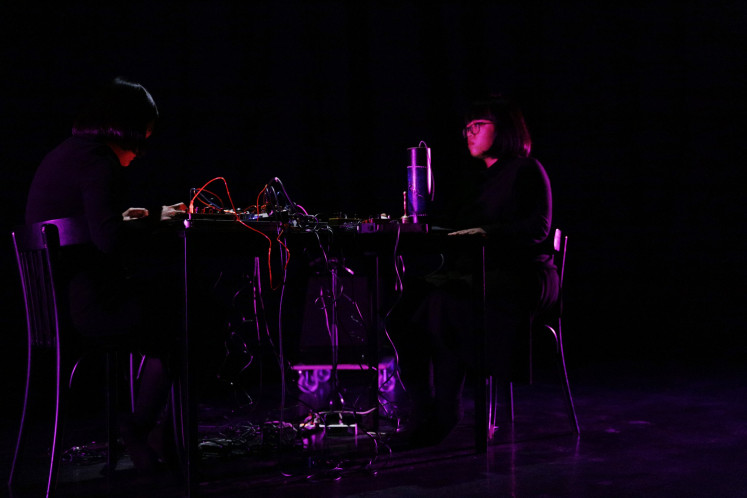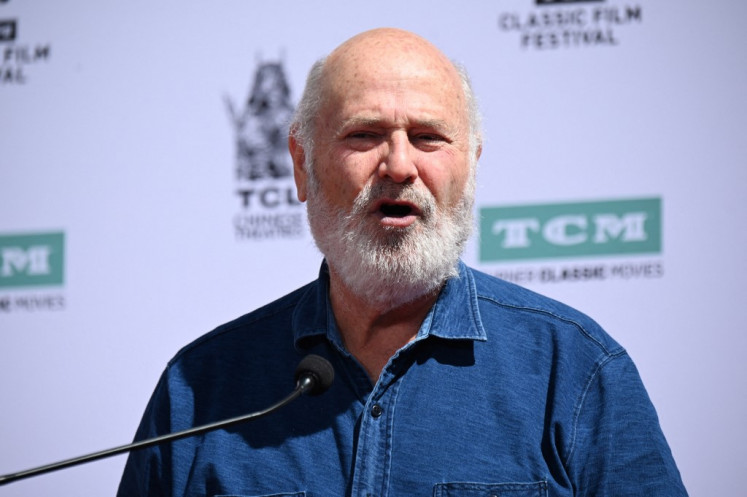Popular Reads
Top Results
Can't find what you're looking for?
View all search resultsPopular Reads
Top Results
Can't find what you're looking for?
View all search resultsIndonesian performers make noise at Berlin’s CTM fest
CTM – Berlin’s Festival for Adventurous Music and Art – brings together performers, musicians and artists from all over the world, including from Indonesia.
Change text size
Gift Premium Articles
to Anyone
I
n a dimly lit room, two young women dressed entirely in black face each other over a table that is stuffed with mixers, soundboards and a tangle of cords and cables; they begin their performance with a steady, monotonous beat, only to add more sounds and noises as they progress, from soothing to screeching.
It seems as though they are engaged in a dialogue with one another: an initially calm conversation where tension slowly builds and eventually leads to full-on confrontation that ends with one of the performers screaming at the top of her lungs.
Dark: The performance of Sarana, an ambient-experimental unit from Samarinda in East Kalimantan, is part of this year’s CTM Festival in Berlin, Germany. (Courtesy of CTM 2019/Stefanie Kulisch)The performance of Sarana, a dark ambient-experimental unit from Samarinda in East Kalimantan, was part of this year’s CTM Berlin – a festival well known for its unapologetic approach to contemporary electronic, digital and experimental music.
The festival, which celebrated its 20th anniversary this year, brought together performers, musicians and artists from all over the world, including more than 20 participants from Southeast Asia, for its 10-day program.
“I still can't believe that we were part of the best festival in the world,” said Annisa Maharani of Sarana. “I was honored to perform at CTM and am grateful to have seen amazing performances from many awesome artists. This is something that only happens once in a lifetime.”
Sarana itself was born when Sabrina Eka, who was already active in Indonesia’s noise music scene, spontaneously asked Annisa and Istanara Julia Saputri to come on stage with her to perform.
Although Annisa and Istanara had never seen any noise performance before, they started to improvise – and it worked out perfectly.
Sarana’s first full-length album Grow was released in June 2018. Currently, Sabrina and Annisa are performing as a duo.
Speaking about their appearance at the CTM festival, Sabrina said the performance was about “a person whose tastes and likes are being shoved in by big corporations that want to sculpt brain patterns and thoughts into what is appropriate for them”.
Annisa, however, had a different approach, explaining she thought it was about entering a person’s head with multiple personalities: “In their heads, there will always be chaos, and it is hard to control”.
Among the Indonesian performers at CTM, Sarana was the only female duo; their fellow countrymen who were also part of the festival included Rully Shabara, Wok the Rock, Gabber Modus Operandi and Tarawangsawelas.
It is no coincidence this year’s line-up included so many Southeast Asian and Indonesian performers, as the festival is one of the main partners of Nusasonic, a multi-year project initiated by the German cultural center, the Goethe Institut, which had its official start in October 2018 with a standalone festival in Yogyakarta, attracting more than 2,000 visitors.
“Nusasonic engages with experimental sound and music cultures in Southeast Asia, Europe and beyond and was created by different partners who have a very strong standing in the respective scenes,” said Anna-Maria Strauss, head of cultural programs at Goethe-Institut Indonesien.
Strauss named Yes No Wave from Yogyakarta, WSK Festival for the Recently Possible in Manila and Singapore’s Playfreely/BlackKaji as the other main partners of the extensive project.
“Nusasonic goes back to the idea of engaging closer with the exciting practices of sound art, noise and experimental music found all over Southeast Asia and facilitating an exchange with the scene in Germany, which is also highly interesting and has diversified a lot in recent years,” Strauss said.
Initially, she added, the Goethe Institut invited Jan Rohlf, artistic director of the CTM Festival, on a networking trip to Southeast Asia to engage with artists, curators and musicians. The connection and mutual interest remained strong and thus the idea for Nusasonic was born.
“It aims to strengthen the artistic network between Southeast Asia, Europe and beyond, to facilitate discussions, co-creation and a process that will create a deeper understanding of each other’s contexts in all their complexities,” Strauss said. “Essentially, Nusasonic wants to be a platform of dialogue.”
Compared to other music genres, experimental sound remains relatively unknown to mainstream audiences, mainly since it is not as easily accessible to the untrained ear. The Goethe Institut, however, didn’t see this as an obstacle when it plunged into the broad field.
“The starting point was the thriving scene in Southeast Asia,” Strauss said. “Noise music in particular is – in stylistic variations – in many countries the basis for vivid subcultures. Choosing to make music in this particular way relates strongly to the society the artists develop their practice in. We were interested in this sense of reflecting your current situation, your socio-political context through sound.”
According to Strauss, many experimental musicians in Southeast Asia and Indonesia are heavily invested in building their infrastructure and actively creating their communities and the societies they live in.
“These strategies are all very interesting and – looked at from a more abstract level – highly relevant to strengthen civil societies, artistic expression and to finding modes of working and living together in a globalized world,” she explained.
Rully Shabara, who hails from Palu in Central Sulawesi and has been involved in both solo and numerous group projects that explore oral traditions, folkloric texts and the human voice, initiated group Setabuhan in 2017 with the intention of presenting a modern reinvention of tribal trance music.
Setabuhan, which brings together the two heavy percussionists Ramberto Agozalie and Caesarking and Rully’s voice as the only other instrument, delivered a raw and energetic performance at CTM, leaving the audience both pumped and breathless.
Setabuhan’s live performances are often accompanied by martial arts or freestyle fighters on stage. In Germany, they worked with a group of pencak silat fighters from Berlin.
“[We aim] to create an ultimate spectacle of performance art inspired by different traditional forms of entertainment, where body contacts and aggression are used to get people together,” Rully said. “Taking this concept and applying it on a contemporary audience is certainly refreshing.”
By collaborating with pencak silat fighters in Germany, the performance had a familiar Indonesian feel, but Rully added that the audience participation was slightly different: “rougher than in Indonesia”.
Speaking about the experimental music scene in general, he noted it has been thriving over the past couple of years.
“We have received a lot of global spotlight and compared to other Southeast Asian countries, Indonesia’s scene is vastly developed and the most exciting,” he said. “You can almost feel that soon it will be huge, like in Japan in the 1990s or early 2000s.”
After highlighting Nusasonic and Southeast Asia at the CTM festival, the project is to be continued and further developed in its home region.
“There will be Nusasonic residencies in Manila and Yogyakarta and small-scale concerts hosted by Playfreely/BlackKaji in Singapore,” Strauss said. “Looking to October 2019, Nusasonic will also make a bigger appearance at WSK Festival’s 10th anniversary edition in Manila.” (ste)












